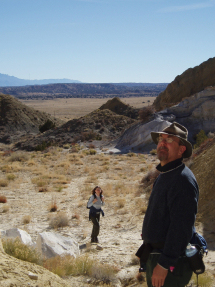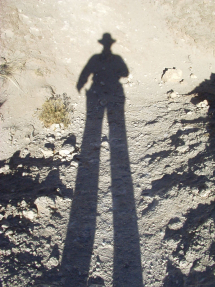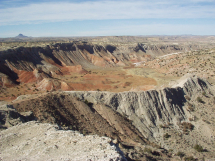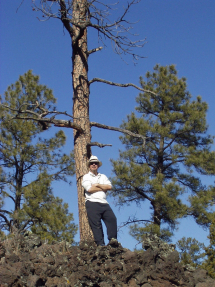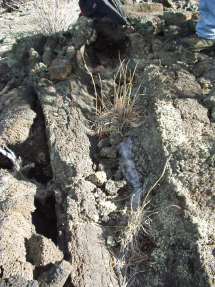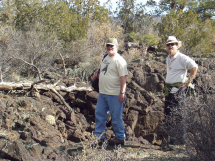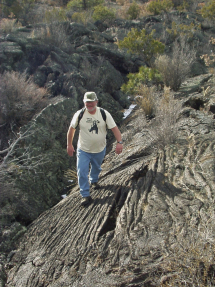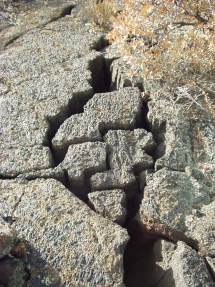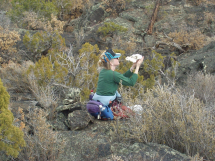Another occasion in the wilderness with James, this time with the family in Ojito Wilderness, northwest of Albuquerque, New Mexico. Starkly beautiful.
Category Archives: wildlands
Hiking the Zuni-Acoma Trail in El Malpais
We did this in 2003 — 20 years ago!
Protected: Platoro
The People of the Gila Watershed
Worth a read. Chaco is outside of this region but must have had contact with its people.Â
Life of the Gila – Archaeology Southwest
In this new series of essays at the Preservation Archaeology blog, we will highlight the deep history of the Gila River Watershed, focusing on how archaeology and knowledge shared by Tribal citizens come together to tell a story of continuity and change that began millennia ago and continues to the present. Each Friday through the end of March, we will post a new essay in this series. Next up: Jeff Clark on identities, worlds, and ideologies.
Three wildlife corridors preserve land and wildlife
Eastern Wildway News – Wildlands Network
News about Eastern Wildway The Eastern Wildway is home to a broad diversity of wildlife, including red wolves, Canada lynx, cougars, martens, and other native carnivores. Many resident plants, birds, fish, salamanders, and butterflies are found nowhere else on Earth. Stretching from eastern Canada to the Gulf of Mexico, the wildlife corridor traverses a wide array of eco-regions and climates, and contains some of North America’s most beloved national parks, preserves, and scenic rivers.
Western Wildway News – Wildlands Network
The Western Wildway is Wildlands Network’s vision of the world’s most extensive network of protected, connected lands. The 6,000-mile Western Wildway will provide wide-ranging wildlife like wolves, cougars, and other animals with room to roam, while also sustaining important ecological processes like pollination and carbon storage, and safeguarding our natural heritage for future generations.
Pacific Wildway News – Wildlands Network
The Pacific Wildway will reconnect, restore, and rewild the Pacific region of North America, from British Columbia to Baja California. It will provide protections for countless wildlife native to the Pacific region, including gray wolves, wolverines, grizzly bears, northern spotted owls, orcas, and salmon.
Saving a wildlife corridor in North America
Western Wildway – Wildlands Network
In western North America, Wildlands Network envisions the world’s most extensive network of protected, connected lands: the 6,000-mile Western Wildway, also know as the Spine of the Continent.
As part of the Western Wildway Priority Wildlife Corridor, Caja plays a critical role in connecting a vital wildlife corridor that runs along the Upper Rio Grande Watershed from the state of Colorado through New Mexico. The plateau and canyons are vital habitat for a diverse range of plants and animals. Beyond the large, iconic predators and prey, the Caja is home to gray fox, badger, burrowing owls, mountain plover, long-billed curlew, and spotted bat. A threatened songbird, the gray vireo, can be spotted among the junipers and piñons on the plateau. The Caja is one of the last great opportunities to protect the West as it has existed for thousands of years.
BLM Defers on Fracking Leases near Chaco Canyon | Archaeology Southwest
BLM Defers on Fracking Leases near Chaco Canyon | Archaeology Southwest
BLM Defers on Fracking Leases near Chaco Canyon
Yesterday, the Bureau of Land Management deferred for the third time the sale of three oil and gas lease parcels and approximately 2,122 acres of federal mineral estate on Navajo allotment lands in the Greater Chaco region. A broad coalition of local and regional watchdog groups submitted comments opposing the lease sale for fracking near Chaco Canyon, a UNESCO World Heritage Site. The comments focused in part on the agency’s woefully insufficient management plan for the region, which treats the Greater Chaco’s communities and landscapes as a sacrifice zone. BLM’s deferral of these leases, for the third time, illustrates the need for the agency to complete its ongoing resource management plan amendment before continuing to lease and authorize the development of any additional public lands for oil and gas. http://bit.ly/1LSSdPZ – Pagosa Daily Post
BLM Defers on Fracking Leases near Chaco Canyon | Archaeology Southwest
An experiment in privatizing public land fails after 14 years — High Country News
An experiment in privatizing public land fails after 14 years — High Country News Tom Ribe Opinion Feb. 12, 2015 Web Exclusive
It is no secret that some state legislators in the West want to boot federal land management agencies from their states. They argue that agencies like the Bureau of Land Management and Forest Service cost too much and are too detached from local values, and that states could make money by running our vast open spaces like a privately owned business.
The Cato Institute, a Washington, D.C.-based libertarian think tank, is of that opinion and has developed models to replace federal agencies with private interests. What many people don’t know is that Congress implemented one of the Cato Institute’s ideas in 2000, on the 89,000-acre Valles Caldera National Preserve in New Mexico. For some critics of the federal government, this was the experiment in land management that would signal the end of the BLM and Forest Service in the West.
The Cato experiment in New Mexico, however, failed, chewed up by the friction between monetizing the “services†that landscapes provide — recreation, timber, grass, wildlife — and fulfilling citizens’ expectations for public access and protecting natural resources. For example, New Mexicans had very little tolerance for paying high fees to visit public property that had already been paid for using federal Land and Water Conservation Fund dollars.
An experiment in privatizing public land fails after 14 years — High Country News
Video shows only known U.S. jaguar roaming Arizona mountains threatened by open pit mine
By Astrid Galvan / Associated Press
Published: Wednesday, February 3rd, 2016 at 1:35pm
Updated: Thursday, February 4th, 2016 at 12:10am
TUCSON — The only known wild jaguar in the United States is seen roaming around a creek and other parts of a mountain range in southern Arizona in the first publicly released video of the giant cat.
“El Jefe†— Spanish for “the boss†— has been living in the Santa Rita Mountains about 25 miles south of downtown Tucson for over three years, according to the Center for Biological Diversity.
El Jefe is about 7 years old and is one of only four or five jaguars that have been spotted in the U.S. in the last 20 years. He’s the only documented wild jaguar in the country.
“A lot of people have no idea that we have jaguars in the United States or that they belong here,†said Randy Serraglio of the Tucson-based environmental group. “In bringing this video, we hope to inspire people to care about these animals and support protection for their homes.â€
Conservationists say El Jefe’s habitat is threatened by a proposed open-pit copper mine in the mountains. The proposed Rosemont Mine has been in the works for several years but is tied up in the permitting phase.
Public access to NM’s Sabinoso Wilderness almost there – ABQJournal Online
Public access to NM’s Sabinoso Wilderness almost there – ABQJournal Online
SANTA FE, N.M. — Public access to New Mexico’s 16,000-acre Sabinoso Wilderness – entirely “landlocked†by private land – moved closer to reality today on news the nonprofit Wilderness Land Trust bought adjacent property that could soon allow hikers, hunters, backpackers and others access to it.
The purchase of the 4,176-acre Rimrock Rose property, made possible by a $3.1 million contribution from the Wyss Foundation, could allow public access to the Sabinoso by summer.
“We’ve been working on creating access to the Sabinoso Wilderness since it was proposed for designation,†said Reid Haughey, president of The Wilderness Land Trust. “To the best of our knowledge, Sabinoso is the only wilderness area among the 762 wilderness areas within the National Wilderness Preservation System that does not have public access.â€
The Sabinoso Wilderness, created by Congress in 2009, is a rugged back-country area east of Las Vegas, N.M., that is home to mule deer, bobcats, gray foxes and a wide range of plant and animal species that are home to the high plains. The headwaters of the Canadian River runs through the Rimrock Rose property and Canyon Largo.
“We are proud to be able to help local leaders and The Wilderness Land Trust as they expand access for fishing, hunting, hiking, and recreation in New Mexico’s prized backcountry,†said Molly McUsic, President of the Wyss Foundation.
Public access to NM’s Sabinoso Wilderness almost there – ABQJournal Online
A rancher defends the BLM (read it)
Penni Ericson – Here’s my original post: Just wanted to say thanks…
Here’s my original post:
Just wanted to say thanks for keeping me up on the Malheur travesty. As a BLM grazing lease holder for nearly 40 years here’s what I’ve experienced with the “tyrannical” agency.
1. BLM grazing is CHEAP. $1.69 an AUM for a month of grazing vs. over $20 for private grazing land. That’s for a cow and calf. For a month.
2. Just like any other lease there is a date on and a date off. Determined by the BLM based on factors like drought/wild horse use/pasture quality etc.
3. In drought years we are offered a “non-use” option and pay no fees at all. In this way we work together to ensure there will be grass left to grow when the rains do come.
4. Our local BLM has a small budget and has an unbelievably large area to oversee. Faced with a growing wild horse problem, we tackled fencing them out of our property on our own. Faced with a threatening allotment holder to our private property, again, no money for fence.
5. When we did fence, they were ecstatic. They offered us all the technical information they could. We once watched a range tech literally dance at the sight of healthy, vibrant Idaho fescue.
6. They protect the land from those who would destroy it, for fun or profit. When we sought to stop destructive driving across our land to get to the BLM for 4 wheeling, they cooperated and supported us, and gave the 4 wheelers another way to access the BLM.
Here at the Diamond E Ranch we feel it’s a privilege to live and work near a large piece of publicly owned land. A treasure we’ve been entrusted with by our fellow Americans. All of them. Our grazing lease allows us to participate in the care of that treasure, not for gain, but for the joy of our new grandchildren who will grow up roaming it like our children did. For the life of me I can’t see anything but profit in Ammon Bundy’s eyes.
Penni Ericson – Here’s my original post: Just wanted to say thanks…
[hat tip to Judy Liddell]
The folly of “taking back” the West — Western states agreed to disclaim lands in order to become states
The folly of “taking back†the West — High Country News Ted Williams Opinion Jan. 20, 2016 Web Exclusive
Do 700 million acres of national parks, national monuments, national forests, national wildlife refuges and Bureau of Land Management units belong to you and your fellow Americans? No, according to the increasingly popular notion in the West that it’s time for states to “take back” federal land.
“Taking back” property that belongs to Alaskans and Floridians and everyone in between is even a plank in the GOP platform. A resolution, entitled “In Support of Western States Taking Back Public Lands” reads: “The Republican National Committee calls upon all national and state leaders and representatives to exert their utmost power and influence to urge the imminent transfer of public lands to all willing Western states.”
Taking back something that never belonged to you presents multiple problems, not the least of which is semantics. But this has never discouraged proponents whose first order of business is to ignore constitutional law.
Here’s a fact they don’t want you to know: As a condition for entering the union, Arizona, Colorado, Idaho, Montana, New Mexico, Oregon, Utah, Washington, Wyoming and Nevada disclaimed all legal right and title to unappropriated public lands.
The folly of “taking back†the West — High Country News
Our Trip to Peru, November 2015
We went to Peru in November, 2015. We traveled with a small group of friends, under arrangements made by Dave Mehlman, birdman extraordinaire. In the course of 2 full weeks, from Lima, to Cusco, to Machu Picchu, to the jungle of Manu, I took too many photos. In the 2 months since, I have taken too long to pull out these. I hope you enjoy them.
Each photo is a link to the album of 179 photos. Be sure to look at the 263 photos by Merri Rudd, as well.
(User’s guide: Follow the link to a page of photos. Select any photo for a large version with caption. You can step through photos or use the Slide Show option at the top of any one photo.)
Free Entrance Days in the National Parks (U.S. National Park Service)
Free Entrance Days in the National Parks (U.S. National Park Service)
The National Park Service turns 100 years old in 2016 and we want everyone to join the party! On 16 days in ’16, all National Park Service sites that charge an entrance fee will offer free admission to everyone.
Mark your calendar for these entrance fee–free dates in 2016:
- January 18: Martin Luther King Jr. Day
- April 16 through 24: National Park Week
- August 25 through 28: National Park Service Birthday
- September 24: National Public Lands Day
- November 11: Veterans Day
Free Entrance Days in the National Parks (U.S. National Park Service)





